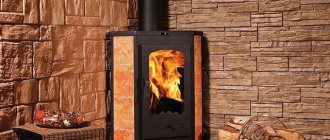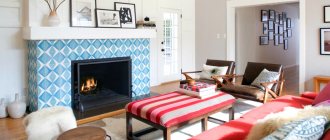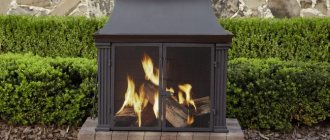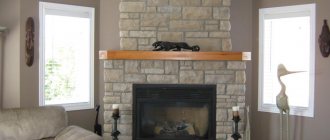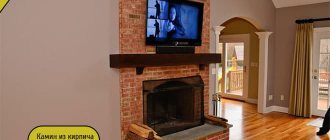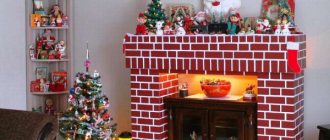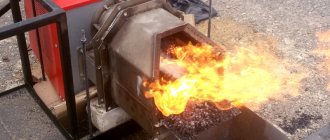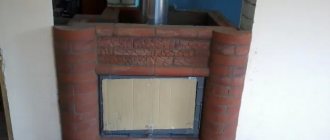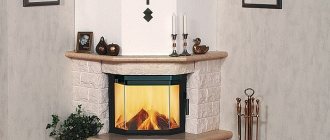06/22/2017 5916 Stove maker (Moscow) A fireplace made of plaster can differ in its shape, size, decorative elements and style. But at the same time, its main characteristics and operational features always remain the same and unchanged.
A do-it-yourself plaster fireplace can be installed both in an apartment building and in a private building. The portal can perform both a decorative function and be intended for installing a purchased fireplace. In this article you will be able to familiarize yourself in detail with the main advantages and features of gypsum, study step-by-step instructions for assembling and designing such a frame.
Features of the gypsum composition
Before assembling and decorating a fireplace with your own hands from plaster, we recommend that you familiarize yourself in detail with all the features of this composition:
| Key Features | Detailed description |
| Fire resistance | DIY gypsum fireplaces are distinguished by their high heat resistance and fire resistance. Such frames are perfect for classic wood-burning structures, in the hearth of which there is a real flame. |
| Versatility | Gypsum is used to make frames not only for decorative and classic hearths, but also those powered by biofuels and electricity. This material does not conduct current, which makes it safe to use and operate. |
| Durability | The price in this case is favorably combined with the durability of the gypsum composition. Over time, it does not darken, does not deform, does not sag or dry out. |
| Plastic | Due to its high plasticity, fairly quick drying and the possibility of additional use of varnish and coloring compounds, gypsum can be used to make structures of any shape and size. |
| Possibility of decoration | Many manufacturers prefer to use gypsum not only for the execution and production of the main part of the fireplace structure, but also for individual decorative parts, decorations, three-dimensional patterns and ornaments. |
Interesting to know: frames made from this material have their own important and unique feature. Gypsum is able to adapt to the unique conditions of a certain room or circumstances. For example, if the room has very high humidity, the structure begins to absorb its excess, and in the case of very dry air, on the contrary, it releases moisture. Thus, the microclimate in the room with a fireplace will be as comfortable and favorable as possible.
To be able to get acquainted with the finished gypsum fireplaces, you can view the photos selected and posted in this article.
Important: despite the many advantages, the gypsum composition has its disadvantages. For example, it belongs to the category of very fragile materials, and if it is constantly in rooms with high humidity, the structure will turn yellow and become less durable.
Manufacturing methods
You can make such a frame using one of the following methods:
- One-piece design. It is represented by one single sculpture made from one large plaster element. Such installations are most often manufactured by highly qualified craftsmen or leading manufacturers with a specific specialization. To make such a frame with your own hands, you need not only extensive experience, but also professional equipment and tools. Due to the difficulties that arise during the work, the cost of such a gypsum portal is quite high;
- Manufacturing of individual elements. In this case, first of all, it is necessary to make a special supporting frame from a metal profile or other durable materials that can withstand the weight of the gypsum. After creating the frame, it must be covered with plasterboard, after which the master attaches various details, patterns, decorations and other plaster elements to its surface. The second method makes the cost of the portal quite affordable and allows you, if necessary, to make such a model yourself.
Let's dance from the stove
Any construction begins with a project, and before constructing a fireplace, you need to decide on the installation location, appearance, dimensions and materials for the work.
Types of fireplaces
A false stucco fireplace can be made of the following types:
- Reliability - this type completely replicates a real fireplace, with the exception of the chimney. An electric or bio-fireplace with an imitation flame is installed in the firebox; wood, clinker bricks or tiles, gypsum stucco, natural or artificial stone are used for decoration.
- Convention - it is a portal of small depth, decorated in the image of real fireplaces, but without flames. The firebox space is occupied by a decorative woodpile, candles, bookshelves and even ornamental plants.
- Symbolism - an image painted on the wall, just a hint of a fireplace portal - a silhouette without depth, the easiest way to do it is using ready-made moldings or baseboards.
Fireplace type - authenticity
Type of fireplace - convention
Type of fireplace - symbolism
Installing a reliable fireplace will require wiring and additional ventilation, and these are significant financial costs. A conventional fireplace with a beautiful portal is no less decorative than a real one, although it will not provide warmth. The symbolic one is more suitable for children's or youth interiors; it is the easiest to implement. The choice is up to the apartment owner.
Installation location
When choosing a place for a fireplace, you need to take into account the area of the room, purpose, layout and arrangement of furniture:
- In a small room, the fireplace can be made in a corner, so it will take up very little space.
- In a spacious room, it can be made the center of the composition in a recreation area with a soft group, and the fireplace can be located either in the center of the room or at one of the end walls.
- Another option is a mobile fireplace, when the portal is mounted on a platform and can be moved at will from place to place and to other rooms.
For a presentable room - a common room, a spacious hall, a living room - a central composition is suitable. In a small office or bedroom with limited space, a corner fireplace is preferable. If you have only one studio room at your disposal, but still want to have a fireplace, then a mobile device will be the best solution.
Plaster fireplace in the interior
Style, texture, color
The style of the building depends on the overall design of the interior; however, in a small room, a fireplace overloaded with details will look small and make the space even more cramped. In a spacious room, a small fireplace will get lost and will not make the right impression.
The stucco molding for the fireplace should match the style of decoration:
- The ancient Egyptian design corresponds to powerful semi-columns or pylons with angular lotus capitals in the form of characteristic Egyptian sculptures, colors - sandstone, turquoise, lapis lazuli, ebony.
- The capitals of the classical orders correspond to ancient Greek or Roman motifs: Doric, Ionic, Corinthian, composite. The mantelpiece is supported by Atlanteans, Caryatids, and Satyrs. The texture of the stucco is marble.
- The Middle Ages - Gothic, Romanesque style is distinguished by simple forms and primitively processed stone - sandstone, limestone, without detailing. The decoration often includes floral motifs - lilies, roses, fantastic creatures - chimeras, dragons, gargoyles.
- The centers of the Renaissance, Baroque and Rococo are marked by a return to ancient traditions and a gradual complication of design and modeling, an abundance of ornaments, curved lines, torn cornices. Attracts attention to the bright color, gilding or silvering of parts, lining with richly colored stones - jasper, onyx, malachite.
- The classicism and empire style fireplace harmoniously combines the traditions of Ancient Greece and Rome with sophisticated baroque decor without the pretentiousness of rococo. The fireplace becomes the compositional center of the decoration - the mantel serves to display rarities, above it is placed a mirror in a precious frame or a painting by a famous master.
- Art Nouveau or Art Nouveau fireplaces are more modest in size, often made of black metal or lined with dark wood. The characteristic decoration - wood carving, plaster stucco or casting - depicts favorite lilies, irises, and a whimsical interweaving of geometric patterns.
- In modern postmodern, high-tech, techno, and bionic architecture, the fireplace loses its functionality due to the emergence of new types of home heating and becomes a sign of luxury and romance. It acquires a dynamic shape, and closed fireboxes make it safe. A variety of materials and surface treatment methods make a modern fireplace unique.
For small rooms of standard housing, the style of modern classics is best suited - a modest and at the same time sophisticated design will make the room more comfortable, and will demonstrate to visitors the excellent taste of the owners.
Fireplace in classic style
Fireplace in classic style
Materials for installing a fireplace
Plaster stucco for the fireplace is the final stage, decoration. Before this, it is necessary to determine the functional type, size and location of our structure, as well as the material from which the structure will be made. The fireplace portal can be made from the following materials:
- Brick - has a significant weight (1350 kg/m3 without mortar with a permissible floor load of 600-800 kg/m3), requires dismantling the floor under the fireplace and installing it on the foundation, and therefore you should not make a fireplace out of brick in a multi-story building, even if you live on the 1st floor.
- Lightweight concrete blocks - gas silicate, expanded clay, wood concrete - weigh 3-4 times less than brick, but this design is not recommended for installation on a clean floor.
- Metal or wooden frame, covered with slabs of plasterboard, glass-magnesite (SML) sheets, chipboard, fiberboard, OSB, plywood. The most common and economical option. If an electric fireplace is chosen, then for fire safety purposes it is better to make the casing from fire-resistant plasterboard in 2 layers or LSU.
- Cardboard boxes are the simplest option, but stucco molding for a false fireplace made of cardboard is not suitable; it will not support the significant weight of the material.
Refusing brick and lightweight concrete blocks due to the large weight of the structure, and cardboard as an insufficiently durable material, we leave the only possible option for a stucco plaster fireplace - a portal made of a metal or wooden frame, covered with durable, fire-resistant material.
Design
Having considered the possible options, we settled on a false fireplace decorated with candles, with a portal made of a galvanized metal frame, sheathed with Standard class LSU with a thickness of 8 to 10 mm. The style is classic, we will do the stucco molding ourselves.
We draw on a piece of paper or on a computer an image of the structure with all dimensions: the firebox, separately - the portal frame and cladding, stucco molding. Based on the drawings, we calculate the required amount of materials. For the internal lining of a false firebox, you can purchase LSU with a decorative finish to resemble natural stone or brick - this way you will not need to perform additional painting or cladding of these surfaces.
Fireplace drawing
Installation features
In order to assemble fireplaces with your own hands from plaster, you need to familiarize yourself with this step-by-step guide and the useful tips and recommendations presented in it:
- In order to simplify the construction and installation process as much as possible, you can buy ready-made blanks in a specialized store. Such elements require simple fastening to the surface of the frame and subsequent additional coating and surface treatment;
- To make blanks, both polyurethane and gypsum can be used, based on your wishes and preferences;
- Due to its rather large mass, the gypsum portal must be securely fastened. For this, special double-sided fasteners are used. Based on its location, the frame can be attached simultaneously to the wall and floor (corner and wall arrangement), or simply to the floor (island arrangement);
- When making a fireplace with your own hands, you need to assemble a frame from metal profiles, cover it with any heat-resistant material and secure it;
- Gypsum stucco molding must first be formed into certain elements. To do this, you can use special purchased forms. Pour the prepared solution into them and wait for it to dry completely, take out the resulting element, which is completely ready to be fixed on the prepared base.
A simple classic frame that requires additional surface treatment or painting to avoid the characteristic yellowness
Complete fireplace portal made of plaster with a recess for the hearth
Joining elements and hiding gaps with construction sealant
Step-by-step production of various large and voluminous parts
An example of a simple plaster fireplace surround
Important: unlike massive and very heavy brick structures, gypsum has a lower mass. That is why installation of such a frame is possible on any floor. You can be sure that no matter what your flooring is, it will support the weight of the frame, and in this case there is also no need to build an additional foundation and obtain permission to carry out installation. Exceptions include wood and gas installations, in which case a permit is required for the chimney and gas exhaust.
The video in this article will help you become more familiar with the basic rules and subtleties of assembling a plaster frame.
Finishing work
If all the steps are completed according to the instructions described, then the DIY stucco molding should turn white after 24 hours of drying. At this stage, the part is polished, defects are removed, and brought to the desired appearance. For leveling, use fine sandpaper. You must act carefully so as not to damage the fragile part. Then the parts are coated with a primer.
Sanding of finished products
The plaster figure has a matte white color. Having covered it with colorless varnish, we get a decoration ready for installation. Alabaster stucco in a natural shade is used in many interiors. But if, according to the idea, the figure should have a different color, then it is painted with water-based paint or patinated. It is more convenient to do painting before attaching the parts.
Additional features
To get acquainted with the options for additional decor, this instruction with the presented ideas and variations will help you:
- If you want to perform additional decoration of the external facades of the fireplace, it is possible to use and secure with special glue, purchased or self-made moldings, a cutter, three-dimensional parts;
- To protect the surface from damage and yellowness acquired over time, both full and partial painting is possible. For this purpose, acrylic and water-based paints and varnish compositions are used. In classic and retro styles, gilded painting is often used;
- You can decorate the inside of the fireplace with ceramic tiles or any other materials. To complete the look, place in the combustion chamber: candles, logs, backlight or LCD monitor;
- You can decorate the nearby space with thematic details necessary for caring for a classic wood-burning heating unit: poker, firewood rack, scoop.
Complex and professionally executed stucco molding
Decorative plaster frame in a classic style
Decorating the fireplace with candles and stones
Types of material for decorating rooms
The most popular and in demand types of material are:
- brick;
- torn (wild);
- rubble;
- original.
Brickwork is the most commonly used type. Red tiles are suitable for decorating rooms in Provence, country, and rustic styles. It is also used to decorate the fireplace wall. White tiles are used to decorate surfaces in loft and Mediterranean interiors.
It is customary to decorate eco-style interiors with torn and wild bricks. This type of masonry is an imitation of natural stone. Gypsum tiles are similar to slate or other natural material mined from the mountains.
Gypsum decorative stone in the bedroom interior
The original includes the rest of the finishing materials made of gypsum, imitating natural rocks. They differ in shape, color, pattern and are suitable for covering surfaces in interiors of different styles.
Gypsum decorative stone for painting
Manufacturing of decorative elements
Despite the large assortment of ready-made gypsum products in specialized stores, even in the absence of special tools and experience in working with this material, you can make the decor yourself.
Tip: in order for the patterns and ornaments to be favorably combined and harmonized with the interior of the selected room, you can copy some details from your furniture, wallpaper and other textures. Repeating a given pattern will not be difficult due to the good flexibility and plasticity of the gypsum mortar.
In order to make parts, it is necessary to select the correct consistency of the solution, which can be of different thicknesses:
- For a very thick solution, you need to add about 400-600 milliliters of water per kilogram of dry gypsum;
- To obtain a mass of average density, per kilogram of gypsum, add from 650 to 750 milliliters of water;
- A very liquid consistency is achieved by diluting one kilogram of dry matter with 850-1000 milliliters of water.
Additional volumetric parts attached to the upper part of the fireplace façade
Do-it-yourself application of small parts to the surface
Large selection of ready-made decorative parts and elements
The use of painting on gypsum stucco
Important: if you are going to sculpt a large element, you should not mix a large amount of solution, as it will quickly become unusable and dry out. The smaller the element you need to make, the more liquid the prepared consistency should be!
The following tips may help you during the sculpting process:
- Before starting work, it is necessary to draw up a preliminary sketch, which will indicate the quantity and location of each pattern;
- At the second stage, draw each decorative element on the surface of the frame. For convenience, use a stencil and a ruler;
- The prepared composition must be applied evenly, in a small layer, to the entire surface of the prepared frame;
- According to the marks made, a thicker layer of gypsum is applied to certain areas and thus three-dimensional parts are formed. All excess mortar must be removed before it hardens;
- After complete drying, each element and surface of the structure must be sanded and rubbed.
Tip: to make more complex and voluminous parts, it is recommended to make them separately and, after complete drying, attach them to the surface of the fireplace with glue.
Tool
Making a bas-relief will require you to acquire some special tools. Not very expensive, but you can’t count on success without it. First of all, half a rubber ball for kneading the next portion of the working mixture. Everything falls out of it at once if you turn it inside out, and the dried remains fly off in the same way. The bas-relief will be stronger and more beautiful the faster it is formed, i.e. the further the working solution is from the beginning of setting. The kneading ball eliminates wasted time on shaking, scraping, etc. to zero. It is also more convenient to collect the solution in small portions from a ball, because... There are no corners inside. For the same reason, the batch turns out to be more homogeneous (homogeneous), and this is one of the most important factors in the final artistry of the bas-relief.
Tools for making bas-reliefs from gypsum
Next, you will need spatulas for modeling - palette knives. Set of 6 pieces (item 1 in the figure) is enough for a start. For forming bunches of grapes, scales, etc. Convex-concave spatulas are also needed. Sets with these are expensive, up to 30 thousand rubles. (!) for a set of 48 items, so amateurs often use spoons of different sizes instead (coffee, tea, dessert, table), with rounded and pointed tips. However, you can’t just create low relief with spoons; the bend of the handle gets in the way. Therefore, for each spatula, take 2 spoons made of aluminum and other ductile metal. One is used as is, it will be a convex spatula. And the other handle at the scoop itself is twisted 180 degrees and bent back, you get a concave spatula.
You will also need another palette knife - an artistic knife, pos. 2. Painters use it to clean off old paint from the palette, and sculptors trim the edges, cut off the flash, and create a fine texture. A palette knife can be perfectly replaced with a wide shoe knife.
The next necessary tool is a pastry syringe with nozzles (items 3 and 4) and, possibly, a 20 ml medical syringe without a needle. It is highly advisable to take a confectionery syringe with a trigger drive (item 4). Mixtures for bas-reliefs are not nearly as fluid as cream for cakes, and you need to form twigs, roses, leaves with a syringe (well, we’ve all seen how to decorate cakes) by holding it with both hands; Hold the instrument at the tip with your left hand.
Finally, you will need 2-3 flat painting brushes of different sizes and the same number of round, cheapest, ox-ear bristles. There is no point in buying expensive squirrel and kolin for bas-relief “for the sake of coolness”, they are too soft. You will also need a very hard and rough children's nylon brush for painting. Use brushes to create texture (see below) and plaster small areas of the bas-relief.
Working with and caring for the tool
Palette knives and brushes are dipped in water before adding the next portion of the mixture. Residues and drips on the working part are the key to spoiled work. After work, the syringe is disassembled and lowered into water in parts; Palette knives and brushes are also placed there. When the instrument becomes acidic, the remaining working materials are thoroughly washed off with clean water. By the way, a properly cared for pastry syringe after working on the bas-relief is also suitable for use for its intended purpose. All instruments must be stored absolutely clean.
What do the professionals advise?
To ensure that the installation and production of the portal takes place at the highest level and you do not encounter any serious problems, we also recommend that you additionally familiarize yourself with the tips and recommendations from leading experts and craftsmen:
- To make voluminous and large elements, you will need a special mold, which you can make yourself. To do this we use simple plasticine. In order for the part to be easily removed after drying, the first layer is applied exclusively with a thin brush;
- Additionally, the plasticine mold can be treated with a weak soap solution. This will also make subsequent extraction easier;
- Before pouring the composition, you need to shake it well, so all the air will leave it. The solution is poured gradually, in layers of no more than 1-2 centimeters, after the previous layer has completely dried, the next one is poured until the mold is completely filled;
- After complete drying, the element is removed and sanded. In order to speed up the drying process, you can place the handicap in an oven and heat it at a temperature of up to +170 degrees;
- A special adhesive composition is used for fixation and fastening.
A fireplace made of plaster is not only a worthy decoration for any interior, but also a high-quality frame that is equally suitable for both classic fireplaces and electric, bio and decorative fireplaces.
Tip nine: make moldings
Moldings are decorative overhead elements used in architecture. They are used to decorate house facades, decorate arches, openings, surface joints and other details. Moldings are divided into two types:
- smooth and symmetrical;
- relief with inclusions of ornaments and patterns.
Gypsum is often used to assemble a whole set of wall decorations. These are modules that are quite easy to install and give the walls the missing elegance and volume. Modules should be selected solely in accordance with the size of the room and the height of the ceilings, so as not to overload the perception.
Preparatory procedures
Before you start creating stucco, you need to stock up on working materials and tools, prepare a sketch of the future decor and make a mold for it.
You will need:
- spatulas and knives of various formats;
- building gypsum;
- art or construction plasticine;
- brush;
A set of necessary tools
- silicone-based putty;
- silicone oil;
- release agent;
- dye;
- colorless varnish.
If this is your first time doing stucco, it is advisable to create a sketch of the future decor. Think over the design and dimensions of the product, put the design on paper, and then sculpt a prototype model of the decoration from clay or plasticine.
Next, you need to prepare a mold for casting stucco:
- treat the inside of the prototype model with a release agent;
- mix silicone-based putty and silicone oil;
- apply the resulting mixture to the model with a brush - the thickness of the coating should be at least 4-5 mm; the maximum size will depend on the complexity of the intended decor.
It is important to apply the silicone mixture in smooth strokes so that no air bubbles remain underneath - they will subsequently cause the appearance of unaesthetic depressions that will spoil the appearance of the stucco molding. When the composition has dried, separate the model from the finished mold. Plaster mold
Plaster mold
To be fair, it should be noted that you don’t have to make the mold yourself either - if you want to play it safe, you can buy it at a craft store.
How to restore
Over time or due to mechanical damage, the gypsum decor is destroyed. In this case, restoration of worn parts or their complete replacement will be required.
Renovation Tips
When carrying out restoration activities, the following recommendations are taken into account:
- Before starting reconstruction, you should study the scale and type of damage, and then choose the appropriate method of exposure or camouflage.
- If a small fragment is destroyed, replacement is not required. Existing damage is repaired directly on the element.
- If the stucco molding has changed color due to getting wet or dirty, the entire product is painted in a color that matches the interior. Water-based paint is suitable.
- Artistic painting will help hide minor scratches. Oil paints are used for this.
- In case of loss of a significant part, restoration work is carried out by checking the photograph, if available.
- If there is no photograph of the lost part, then a new one is made taking into account the general style of the room.
- During restoration, cracks and seams are opened and re-sealed with fresh mortar.
- Weakly fixed parts are removed, the surfaces are leveled and fixed again. In this case, double fastening is recommended - with glue and dowels.
- If paint comes off on an area of a figure, the entire element is painted over. Otherwise, the color of the freshly coated area will be different. To do this, the old layer is cleaned off the part, the surface is sanded, primed and a coating of the desired color is applied.
Step-by-step instructions for creating a pseudo-fireplace from plasterboard
A realistic, hand-made decorative plasterboard fireplace differs from a real one only in the absence of a live fire. Step by step, they begin to build it by creating a drawing and preparing the space for installation.
We create a diagram, layout
The diagram is first drawn on paper, and a layout is created from it. Afterwards, the parts with which it is planned to cover the product are marked on drywall to the appropriate scale.
Preparatory work
At the preparatory stage, the installation site of the structure is selected, cleaned of old coatings, and leveled. The area for mounting a heavy product is additionally strengthened.
We assemble and install the frame
The frame is assembled from aluminum profiles or bars. First, the vertical racks are installed, then the upper strips and additional jumpers. The strict perpendicularity of the parts is checked using a level or square.
Dummy fireplace trim
Before sheathing begins, the parts cut out of plasterboard are tried on to the constructed frame and, if necessary, slightly adjusted. Afterwards, all elements are mounted in their intended places using self-tapping screws. The joints are puttied and sanded.
How to decorate an artificial fireplace
It is permissible to decorate a false fireplace in different ways. Suitable for painting in white color, pasting with ceramic or gypsum tiles, mosaic, colored glass, self-adhesive film, wallpaper. You can also hand-paint it with fancy patterns. Plastic stucco molding, in the form of moldings, cornices, semi-columns or rosettes, corners, will also fit into the theme.
How to decorate a false fireplace
A fake flame looks very unusual in a fireplace structure. It is created using orange and red scarves attached above a small running fan (even a computer cooler will do). Small real candles inside the portal, especially inserted into recesses in wood-fired pieces, will also be a suitable alternative to a full-fledged fire. Using warm-colored LEDs placed in the firebox of a pseudo-fireplace, as well as glass with fire painted on it, a beautiful illusion of “live” fire is created.
Plants are placed inside the portal, which does not have heating elements. These are shade-tolerant fresh potted flowers, freshly cut bouquets in vases, artificial vines. Rag roses, peonies, poppies attached to fabric stretched inside are also suitable. Handicraft lovers even embroider very realistic fire with colored threads.
Torn (wild) stone in the interior
This material looks like real uneven pieces of rock. It can imitate marble, limestone, travertine, sandstone, quartzite, granite and others. Therefore, decorative torn stone comes in different colors and textures. Gray or brown material is suitable for decorating the interiors of country houses. Textured solid wood furniture will be ideally combined with it. A coating that imitates marble is suitable for classic interiors. Elements made from it and gypsum borders look beautiful against the background of Venetian plaster.
Gypsum decorative stone in an English interior
Rules for choosing artificial stone
In all the variety of products offered from this artificial material, it is easy for an unprepared buyer to get confused. To prevent this from happening, it is necessary to identify the main positions by which this material should be selected.
Criterias of choice
Base materials. They can be very diverse - granite, marble, sand chips, gypsum. The choice will depend on preferences and the style in which the stove or fireplace is lined. Safety certificates. In the production of facing materials, many substances containing complex chemical compounds are used. Therefore, a hygienic certificate for the product is required. Type of substrate. Finishing the stove with flexible stone involves the presence of curved surfaces. Regular rectangular blocks are suitable for strict geometry with angles of 90 degrees. Date of production. Artificial elements must rest for at least a month before they can be worked with
Pay attention to the production date of the batch on the packaging
The best manufacturers
Is it possible to line a stove with artificial stone without buying expensive European materials? Below are comparative examples to help you navigate the prices and make your choice:
- Artificial elements of the “Byzantium” series. Russian production from New Technologies Stone. Price per 1 sq. meter - 1130 rubles.
- Artificial alpine slate. Available in several colors. Russian production. The cost is 540 rubles per 0.5 sq. m. meters.
- Gypsum cement tiles "Chateau". Produced by Russian. Environmentally friendly inorganic materials are used as dyes. The price is 290 rubles per 0.5 sq. meters.
- Artificial elements of the Milan series. Russian production from New Technologies Stone. Price per 1 sq. meter - 1064 rubles.
- Artificial cream facing stone REDSTONE Old Peter SP-13/R. Russian production, price per 1 sq. meter will be 1250 rubles.
- Facing elements White Hills Fjord Land, lilac color. Russian production, 45 pieces per package, price per 1 sq. meter will be 1160 rubles.
- Facing elements “Ideal Stone”, Booth collection. Produced by Russian. The cost is 990 rubles per 1 sq. meter.
- Artificial facing stone “Ideal Stone”, Jura marble collection. Produced by Russian. The cost is 1390 rubles per 1 sq. meter.
- White Hills North Ridge siding, white. Russian production, 15 pieces in a package, price per 1 sq. meter will be 1450 rubles.
- White Hills Rutland cladding elements, white. Russian production, 21 pieces in a package, price per 1 sq. meter will be 1320 rubles.
Decorating the fireplace with stucco
At first glance, a stucco fireplace portal is quite simple to make, and it’s really not a difficult job. The most important thing is to make the right design in the right style, so as not to spoil, but to complement the room.
Choosing decor
The stucco molding for the fireplace is selected primarily according to the type of lining of the hearth itself. Here you should also take into account the features and characteristics of operation. Depending on the fuel used, two types of fireplaces can be distinguished.
- Fireplace with natural fire. Only natural combustion products can be used here.
- An electric fireplace that only imitates a flame. This is done with the help of a heater, which helps create the illusion of fire. Here you can adjust the brightness of the flame, add the effect of smoldering coals, etc. This design can be found quite often in the design of premises.
Decorating a fireplace with stucco begins with decorating the opening. This is the most visible place where you can place elements. There is practically no functional load here, but aesthetically it is difficult to find a more convenient place. Therefore, this part should be designed in the most harmonious way; it should maintain the style of not only the fireplace, but also the entire room. The frame is the calling card of the fireplace.
Two types of portal can be distinguished depending on the manufacturing technology.
- A profile portal is a decorative structure in which various types of frieze, moldings and pilasters are used as a frame.
- The portal is sculptural - in this decoration, figures, frescoes and caryatids are in the foreground. You can make quite voluminous structures in the form of columns and sculptures.
Plaster molding is often used to add and display the style of a room. Here you can finish it in both a classic style and a high-tech style. Let's first understand the design style.
Styling of stucco installation
With these simple elements you can always give and display the desired style of the room.
- Decorating the portal with a stone look will add massiveness to the entire product, and it will look great if you want to keep the room in a medieval style.
- To give the room a spirit of antiquity, classic stucco decor is perfect. It can also complement the medieval style.
- The stucco moldings are also artificially aged. This decoration helps create coziness in the room.
- You can also use different combinations of materials in making stucco. This way you will emphasize the individuality of the design.
Additional processing
After drying, all elements of the stucco design are laid out according to the drawing and the quality is visually assessed. All minor defects at this stage are corrected with fine sandpaper, grooves and scratches are covered with gypsum putty, and after drying they are sanded with sandpaper.
You can attach plaster to the portal using special plaster glue or using self-tapping screws.
Imitation of fire for a false fireplace
If you approach your work with passion, even a decorative hearth will look realistic. But the key difference is the absence of fire. The easiest way to bring the look closer to the real thing is to put a few logs of firewood in the firebox. There are more realistic options:
- Built-in bio-fireplace. It works on the principle of an alcohol burner. After ignition, a real flame appears in front of you. Alcohol produces virtually no smoke or odor, making it great for indoor use. To integrate into the portal, you need to choose models that are closed on all sides. They prevent fire.
- Digital photo frame. Gadgets with support for GIF animation and background sound imitate the movement of flames and the characteristic crackling of coals. But large format frames are expensive, and standard seven-inch screens are only suitable for mini-fireplaces.
- LED Strip Light. Bright orange or red lighting is installed in the podium or along the lower contour of the combustion niche. An improvised fire comes to life if you place a transparent container filled with water and glass balls inside. Light is refracted in glass beads. The water sways at the slightest vibration and creates the effect of movement.
